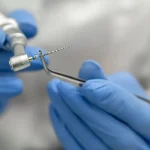
The main purpose of infection control can be briefly summarised as blocking the transmission of microorganisms or pathogens.
This block must be applied in two directions. The first is the prevention of vertical transmission and the second is the prevention of horizontal or lateral transmission.
Prevention of vertical and lateral transmission
Vertical transmission is the propagation of pathogens from one generation to another. Proper use and regulation of antibiotics are essential for preventing vertical transmission, calling for appropriate antibiotic management.
Lateral transmission is the transfer of the resistance of a pathogen to others of the same generation, or the propagation and expansion of the pathogen in the surrounding environment.
Preventing this lateral transmission to the greatest possible extent is a practical point in terms of infection control.
The methods for blocking lateral transmission include the management of healthcare professional hygiene, with procedures such as hand hygiene, and environmental infection control, with cleaning and disinfection protocols.
These measures require knowledge of disinfection or antisepsis and sterilisation[1].
The Spaulding classification
The Spaulding classification, which was first proposed in 1957, can be used for this purpose.
This system is commonly used to pair the disinfection and sterilisation of surfaces, particularly those of reusable medical/surgical devices, with the processes available.
It provides a classification, from simple disinfection through to sterilisation, that should be taken into consideration when reconditioning devices based on the risk associated with their use. It starts from “critical” (presenting a high risk), then proceeds to “semi-critical”, and finally “non-critical” (presenting a low risk).
The different disinfection levels are based on the demonstration of the antimicrobial activity towards established marker organisms, which represent a range of pathogens [2].
The microbiological disinfectant hierarchy
There is a microbiological disinfectant hierarchy. Indeed, microorganisms have a variable intrinsic resistance to disinfectants, which can be shown in this list, from the most resistant (A) to the most susceptible (F):
- Spores (C. difficile)
- Mycobacteria (M. tuberculosis)
- Non-enveloped viruses (norovirus, HAV, polio)
- Fungi (Candida, Trichophyton)
- Bacteria (MRSA, VRE, Acinetobacter)
- Enveloped viruses (HIV, HSV, influenza)
The Spaulding classification provides a strategy for the sterilisation or disinfection of objects and surfaces depending on the degree of risk associated with their use.
Three types of device are considered:
- Critical: equipment that is introduced directly into the human body, blood or areas of the body that are usually sterile.
- Semi-critical: surfaces and equipment that come into contact with intact mucosae and non-intact skin.
- Non-critical: surfaces and equipment that only come into contact with intact skin[3].
This article will focus on virucidal activity and its different efficacy levels.
Virucidal activity: definitions and the European approach
In a narrow definition, virucidal activity, represents the activity by which to interact with and physically disrupt viral particles.
In a broader definition it includes the activity by which to functionally inhibit (neutralise) viral infectivity without apparent morphological alterations of the viral particles, as in the case of antibody-mediated neutralisation[4].
We will now focus on the European virucidal activity levels.
European virucidal activity levels
• Virucidal activity against enveloped viruses: activity against enveloped viruses, such as influenza, including avarian influenza A (H7N9), herpes virus, HIV, HBV, HCV, Zika virus, Ebola virus, corona viruses (including SARS-CoV-2 and MERS- CoV) and flavivirus.
This statement applies to hand disinfection, the disinfection of surfaces and products for preliminary instrument cleaning, which involve a combination of cleaning agents and disinfectants.
• Limited spectrum of virucidal activity: activity against non-enveloped norovirus, rotavirus, adenovirus and enveloped viruses.
This statement applies to hand disinfection and the disinfection of surfaces.
• Virucidal activity: activity against viruses, including non-enveloped viruses (e.g. poliovirus and enteroviruses, such as enterovirus 71 and enterovirus D68) and enveloped viruses.
This statement applies to hand disinfection, the disinfection of surfaces, the disinfection of instruments and the disinfection of tissues[5].
The necessary prevention measures
Disinfectants and antiseptics are part of the package of measures required to obtain the prevention and control of infection in healthcare facilities and the community.
The European tiered approach to classifying virucidal efficacy as “virucidal activity against enveloped viruses”, “limited spectrum of virucidal activity” and “virucidal activity” helps in choosing the most appropriate indication for emerging or re-emerging virus outbreaks, with a tested concentration and contact time.
This results in the correct choice of test method for determining the appropriate use, concentration and contact time of antiseptics and disinfectants [6].
All the products in the Zeta Hygiene range, which are specifically intended for a given application (instruments, surfaces, suction units, hands and impressions), are effective against the main types of microorganism, in accordance with the most recent European standards.
References
[1] https://www.ncbi.nlm.nih.gov/pmc/articles/PMC6031597/
[2] https://www.sciencedirect.com/science/article/abs/pii/S0195670111001988#preview-section-abstract
[3] https://www.epa.gov/sites/default/files/2015-10/documents/rutala_overview_of_current_disinfection_hierarchy_models_final.pdf
[4] https://www.ncbi.nlm.nih.gov/pmc/articles/PMC8275317
[5] https://www.ncbi.nlm.nih.gov/pmc/articles/PMC7848678/
[6] https://www.ncbi.nlm.nih.gov/pmc/articles/PMC7848678/
Do you want more information on Zhermack Dental products and solutions?
Contact us



 Zhermack SpA has been one of the most important producers and international distributors of alginates, gypsums and silicone compounds for the dental sector for over 40 years. It has also developed solutions for the industrial and wellbeing sectors.
Zhermack SpA - Via Bovazecchino, 100 - 45021 Badia Polesine (RO), Italy.
Zhermack SpA has been one of the most important producers and international distributors of alginates, gypsums and silicone compounds for the dental sector for over 40 years. It has also developed solutions for the industrial and wellbeing sectors.
Zhermack SpA - Via Bovazecchino, 100 - 45021 Badia Polesine (RO), Italy.


